
Click the above Computer Enthusiasts to follow us
Qualcomm officially launched the Snapdragon 780G mobile platform recently, with the Xiaomi 11 Youth Edition being the first to feature it. We all know that the Snapdragon 7 series is known for producing ‘God U’ chips, from the early Snapdragon 710, Snapdragon 730 to Snapdragon 765G, they have all earned a good reputation in the mid-range market due to their excellent energy efficiency.As a new product, the Snapdragon 780G features the same 5nm process as the Snapdragon 888, and is equipped with the Kryo 670 core, which is a modified version of the ARM native Cortex-A78 architecture, along with an Adreno 642 GPU that shares its lineage with the Snapdragon 855, making it very appealing.
We all know that the Snapdragon 7 series is known for producing ‘God U’ chips, from the early Snapdragon 710, Snapdragon 730 to Snapdragon 765G, they have all earned a good reputation in the mid-range market due to their excellent energy efficiency.As a new product, the Snapdragon 780G features the same 5nm process as the Snapdragon 888, and is equipped with the Kryo 670 core, which is a modified version of the ARM native Cortex-A78 architecture, along with an Adreno 642 GPU that shares its lineage with the Snapdragon 855, making it very appealing.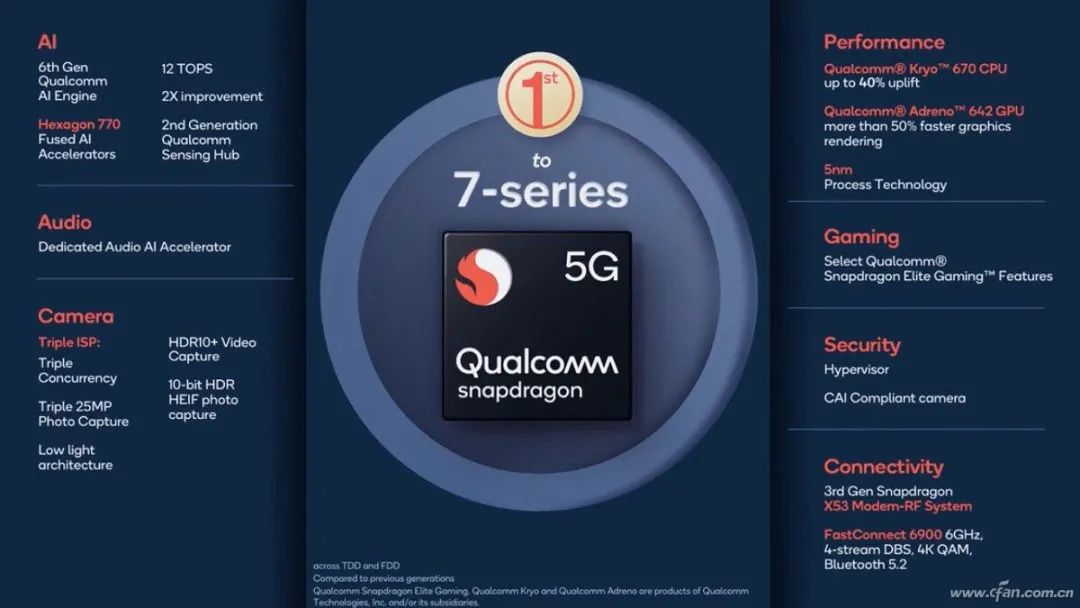 So, can this chip once again be crowned with the title of ‘God U’?As the saying goes, ‘You have to take it out for a walk to see if it’s a mule or a horse’, let’s use familiar benchmarking software to see what level the Snapdragon 780G is really at.First, let’s look at CPU performance.The Snapdragon 780G adopts the trendy ‘1+3+4’ tri-cluster architecture, consisting of 1 core at 2.4GHz Cortex-A78, 3 cores at 2.2GHz Cortex-A78, and 4 cores at 1.8GHz Cortex-A55. The modified Cortex-A78 core performs well, but unfortunately, the frequency setting of the Snapdragon 780G is relatively conservative, so it can only achieve computational power similar to that of the Dimensity 1000+.
So, can this chip once again be crowned with the title of ‘God U’?As the saying goes, ‘You have to take it out for a walk to see if it’s a mule or a horse’, let’s use familiar benchmarking software to see what level the Snapdragon 780G is really at.First, let’s look at CPU performance.The Snapdragon 780G adopts the trendy ‘1+3+4’ tri-cluster architecture, consisting of 1 core at 2.4GHz Cortex-A78, 3 cores at 2.2GHz Cortex-A78, and 4 cores at 1.8GHz Cortex-A55. The modified Cortex-A78 core performs well, but unfortunately, the frequency setting of the Snapdragon 780G is relatively conservative, so it can only achieve computational power similar to that of the Dimensity 1000+.
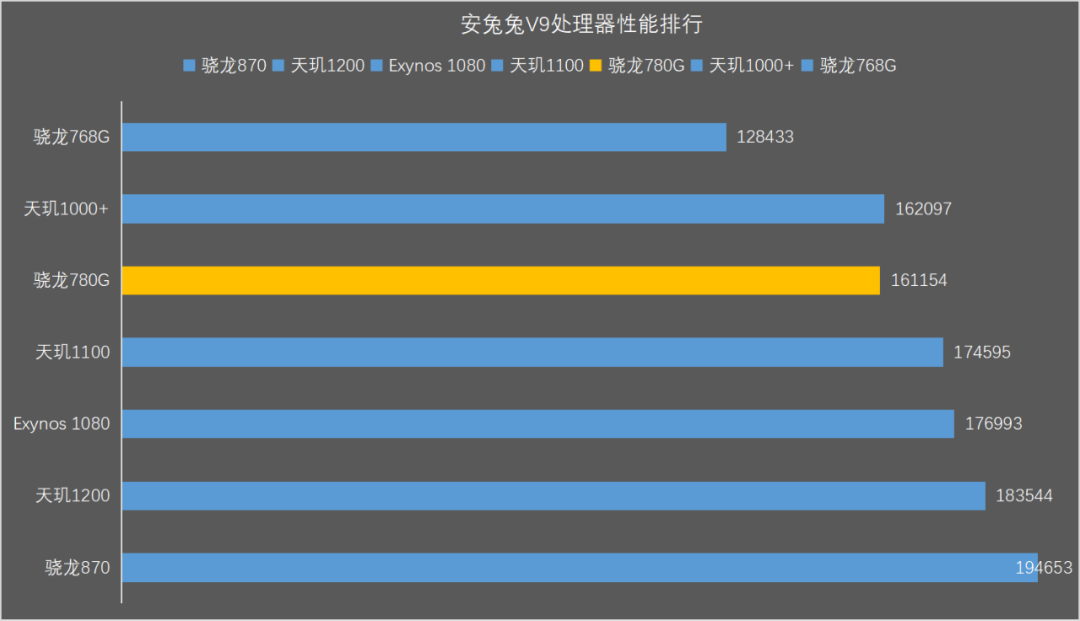
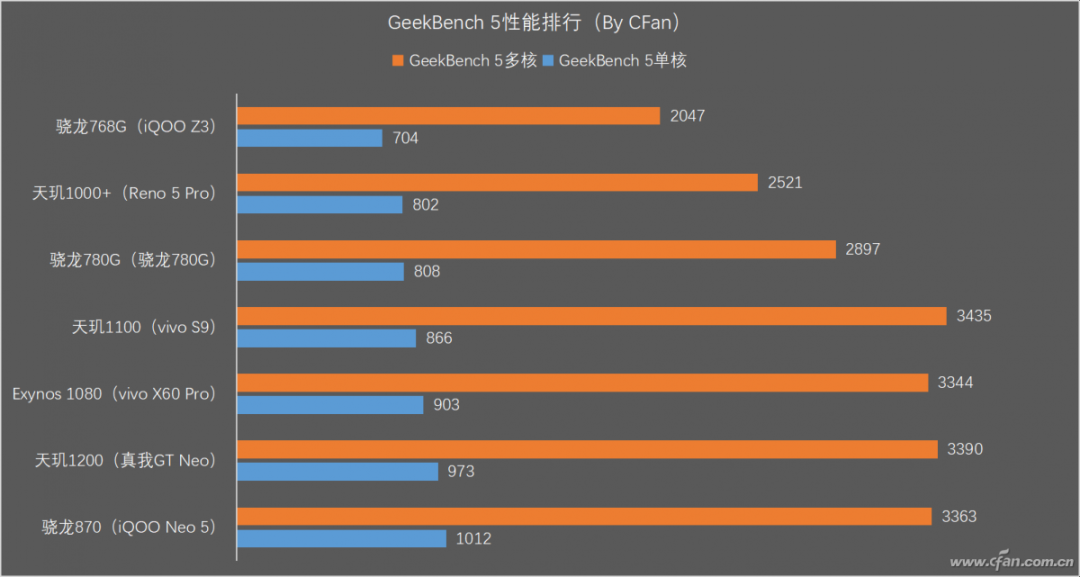 However, this is still a good result. It’s worth noting that the Dimensity 1000+ uses 4 Cortex-A77 large cores (2.6GHz) and 4 Cortex-A55 small cores in a dual-cluster configuration, which is originally positioned very high. The Snapdragon 780G can outperform the previous generation Snapdragon 768G, which has a maximum frequency of 2.8GHz, and naturally can comprehensively suppress mid-range competitors like Dimensity 800 and Exynos 980.Next, let’s look at GPU performance.Qualcomm has paired the Snapdragon 780G with the Adreno 642 GPU. From the suffix, its ALU (Arithmetic Logic Unit) scale should be on par with the Adreno 640 integrated into the previous flagship Snapdragon 855, and it adds support for 10-bit HDR and 144Hz refresh rate screens. However, according to blogger @肥威, the core frequency of the Adreno 642 is only 490MHz, while the core frequencies of the Adreno 640 integrated into Snapdragon 855 and Snapdragon 855 Plus are 585MHz and 672MHz, respectively.
However, this is still a good result. It’s worth noting that the Dimensity 1000+ uses 4 Cortex-A77 large cores (2.6GHz) and 4 Cortex-A55 small cores in a dual-cluster configuration, which is originally positioned very high. The Snapdragon 780G can outperform the previous generation Snapdragon 768G, which has a maximum frequency of 2.8GHz, and naturally can comprehensively suppress mid-range competitors like Dimensity 800 and Exynos 980.Next, let’s look at GPU performance.Qualcomm has paired the Snapdragon 780G with the Adreno 642 GPU. From the suffix, its ALU (Arithmetic Logic Unit) scale should be on par with the Adreno 640 integrated into the previous flagship Snapdragon 855, and it adds support for 10-bit HDR and 144Hz refresh rate screens. However, according to blogger @肥威, the core frequency of the Adreno 642 is only 490MHz, while the core frequencies of the Adreno 640 integrated into Snapdragon 855 and Snapdragon 855 Plus are 585MHz and 672MHz, respectively.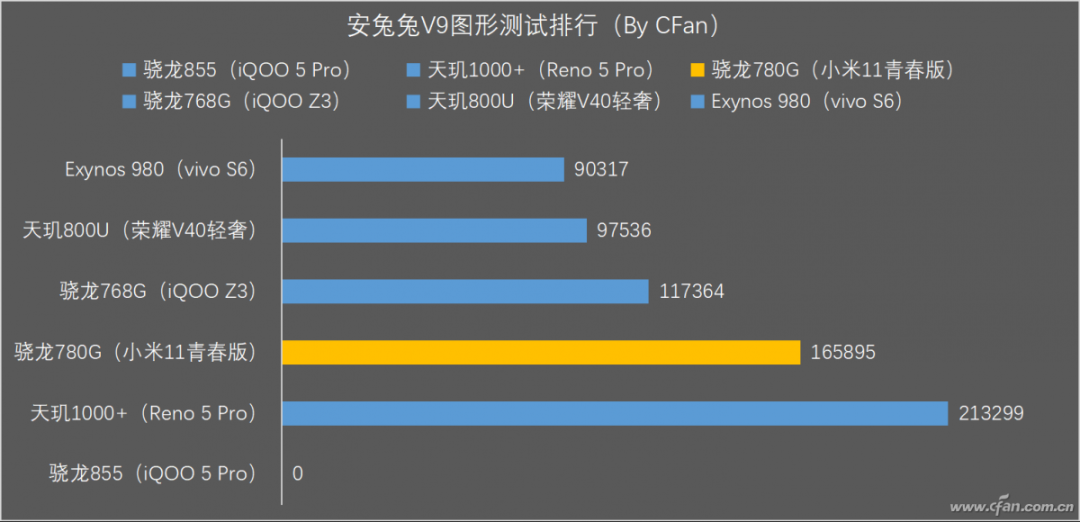 Currently lacking Snapdragon 855’s test data in the new AnTuTu V9
Currently lacking Snapdragon 855’s test data in the new AnTuTu V9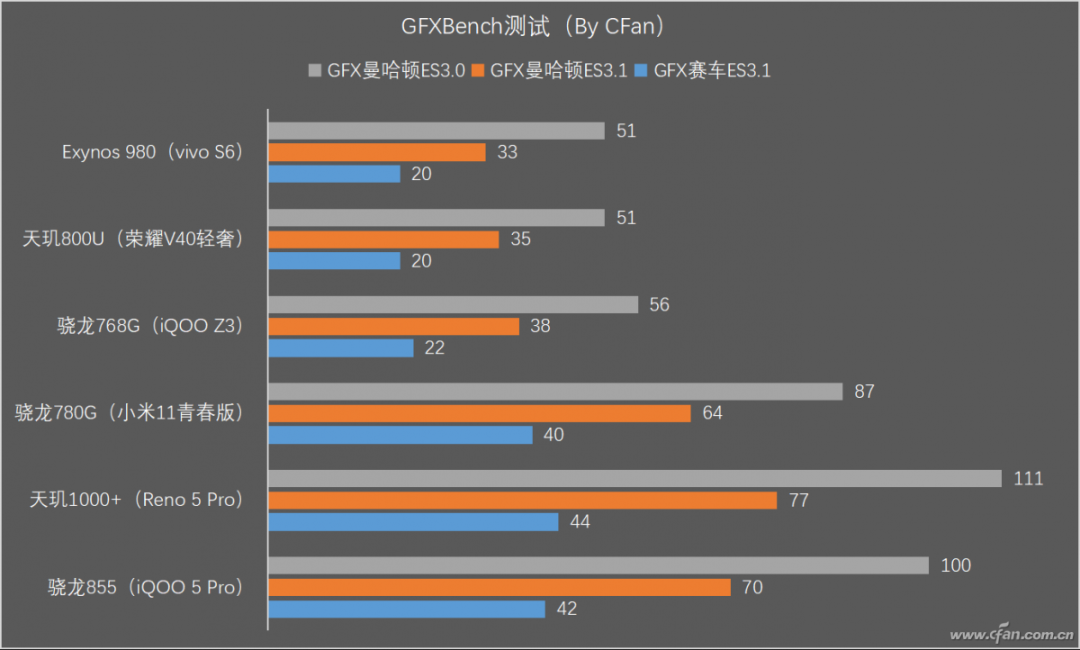 Therefore, don’t expect the gaming performance of the Snapdragon 780G to surpass that of the Snapdragon 855. From AnTuTu and GFXBench tests, the 3D performance of the Snapdragon 780G is only very close to that of the Snapdragon 855, and the gap compared to the Dimensity 1000+ is even larger.But still, the Snapdragon 780G is positioned as a mid-range chip, and compared to the previous generation Snapdragon 768G, as well as mid-range competitors like Dimensity 800 and Exynos 980, the 3D performance of the Snapdragon 780G still has about a 50% improvement, which is quite impressive.In other aspects, the Snapdragon 780G supports LPDDR4X-2133MHz memory and can be paired with UFS2.2 flash storage, meeting the storage standards for mid-range phones in 2021. The Snapdragon 780G also introduces the Spectra 570 ISP, which supports concurrent triple-camera setups in the Snapdragon 7 series, enabling 10-bit HDR HEIF photography and 4K HDR video recording. Additionally, the Snapdragon 780G integrates the Snapdragon X53 5G modem, with downlink and uplink speeds of 3.3Gbps and 1.6Gbps, respectively, but it has removed support for millimeter-wave bands, which is a slight downgrade compared to the Snapdragon 765G. However, the Snapdragon 780G supports Wi-Fi 6E and the 6GHz band through the onboard FastConnect 6900, increasing bandwidth and enhancing connectivity. From a practical standpoint, Wi-Fi 6E and the 6GHz band clearly surpass the ‘elusive’ millimeter-wave (which is not supported by domestic base stations).
Therefore, don’t expect the gaming performance of the Snapdragon 780G to surpass that of the Snapdragon 855. From AnTuTu and GFXBench tests, the 3D performance of the Snapdragon 780G is only very close to that of the Snapdragon 855, and the gap compared to the Dimensity 1000+ is even larger.But still, the Snapdragon 780G is positioned as a mid-range chip, and compared to the previous generation Snapdragon 768G, as well as mid-range competitors like Dimensity 800 and Exynos 980, the 3D performance of the Snapdragon 780G still has about a 50% improvement, which is quite impressive.In other aspects, the Snapdragon 780G supports LPDDR4X-2133MHz memory and can be paired with UFS2.2 flash storage, meeting the storage standards for mid-range phones in 2021. The Snapdragon 780G also introduces the Spectra 570 ISP, which supports concurrent triple-camera setups in the Snapdragon 7 series, enabling 10-bit HDR HEIF photography and 4K HDR video recording. Additionally, the Snapdragon 780G integrates the Snapdragon X53 5G modem, with downlink and uplink speeds of 3.3Gbps and 1.6Gbps, respectively, but it has removed support for millimeter-wave bands, which is a slight downgrade compared to the Snapdragon 765G. However, the Snapdragon 780G supports Wi-Fi 6E and the 6GHz band through the onboard FastConnect 6900, increasing bandwidth and enhancing connectivity. From a practical standpoint, Wi-Fi 6E and the 6GHz band clearly surpass the ‘elusive’ millimeter-wave (which is not supported by domestic base stations).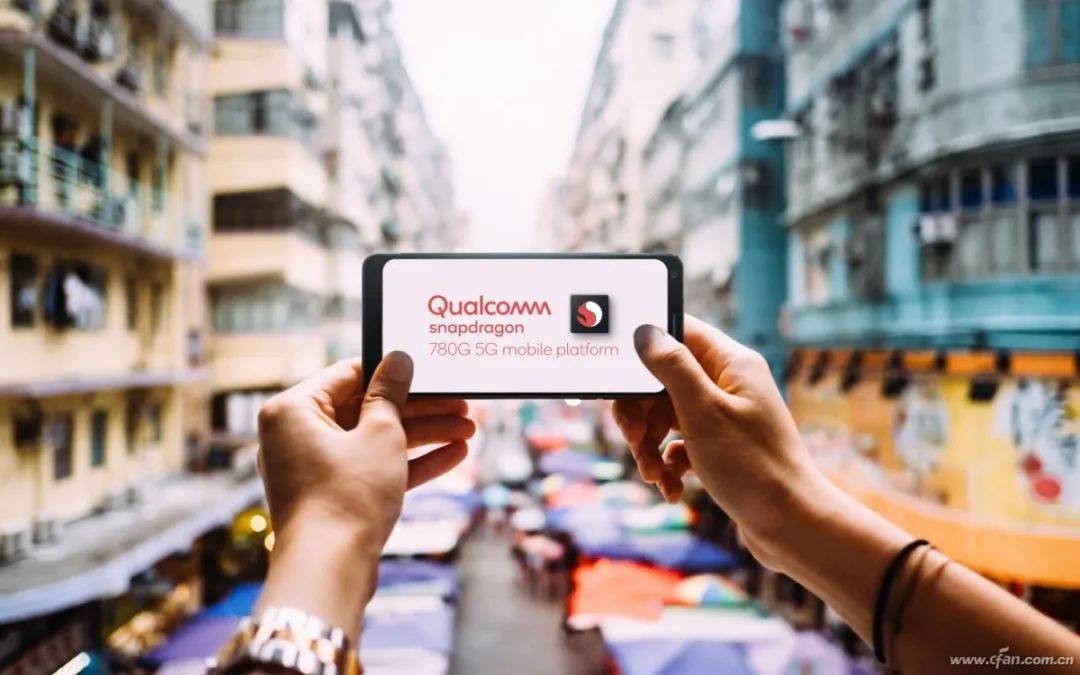 In summary, the performance of the Snapdragon 780G meets expectations.If placed in the mid-range 5G SoC field, it indeed has a performance that lives up to the title of ‘God U’.However, if it is forcibly placed among the Snapdragon 870, Exynos 1080, and Dimensity 1×00, it would only be at the bottom of the rankings.Considering that phones equipped with Snapdragon 870 and Dimensity 1200 are now priced below 2000 yuan, new products featuring the Snapdragon 780G will need to find a price range of around 1500 to 2000 yuan to demonstrate their cost-effectiveness. Of course, if they adopt better processes, screens, or imaging systems, consumers would likely accept a certain degree of premium.
In summary, the performance of the Snapdragon 780G meets expectations.If placed in the mid-range 5G SoC field, it indeed has a performance that lives up to the title of ‘God U’.However, if it is forcibly placed among the Snapdragon 870, Exynos 1080, and Dimensity 1×00, it would only be at the bottom of the rankings.Considering that phones equipped with Snapdragon 870 and Dimensity 1200 are now priced below 2000 yuan, new products featuring the Snapdragon 780G will need to find a price range of around 1500 to 2000 yuan to demonstrate their cost-effectiveness. Of course, if they adopt better processes, screens, or imaging systems, consumers would likely accept a certain degree of premium.

Click “Read the original” for more exciting content